Chart Color Schemes
est. as @ -- *
ABS ERP | -- people | --
2021 Census | -- people
Sales Activity
Curious about local property values? Filter the chart to assess the volume and appreciation (including resales) trends and regional comparisons, or scroll to the map below view this information at an individual property level.
Find a Recent Sale
Sales Detail
Population
An assessment of population growth drivers in Hackett reveals an overall ranking slightly below national averages considering recent, and medium term trends
Hackett's population was 3,227 as of the 2021 Census. By Aug 2025, it is around 3,308, reflecting an increase of 81 people (2.5%). This growth is inferred from ABS data showing an estimated resident population of 3,295 in June 2024 and 13 validated new addresses since the Census date. This results in a population density of 1,696 persons per square kilometer, above national averages assessed by AreaSearch. Overseas migration contributed approximately 83.5% of overall population gains during recent periods.
AreaSearch adopts ABS/Geoscience Australia projections for each SA2 area, released in 2024 with a base year of 2022. For areas not covered and years post-2032, age group growth rates from the ACT Government's SA2 area projections are used, also based on 2022. Projected demographic shifts indicate overall population decline over this period, with Hackett's population expected to grow by 0 persons by 2041. However, specific age cohorts are anticipated to grow, led by the 65 to 74 age group, projected to increase by 76 people.
Frequently Asked Questions - Population
Development
AreaSearch analysis of residential development drivers sees Hackett recording a relatively average level of approval activity when compared to local markets analysed countrywide
Hackett has seen approximately 12 new homes approved annually over the past five financial years, totalling 61 homes. In FY-26 so far, one approval has been recorded. On average, 2.4 people have moved to the area per year for each new home constructed between FY-21 and FY-25, indicating solid demand that supports property values. New homes are being built at an average expected construction cost of $307,000.
This financial year has seen $144,000 in commercial approvals, demonstrating the area's residential nature. Compared to the Australian Capital Territory, Hackett shows substantially reduced construction activity, with 73.0% below the regional average per person. This scarcity typically strengthens demand and prices for existing properties. Recent construction comprises 58.0% detached houses and 42.0% attached dwellings, offering a mix of medium-density options across price brackets. This represents a shift from the area's existing housing composition, currently at 76.0% houses, indicating decreasing availability of developable sites and reflecting changing lifestyles.
Hackett shows characteristics of a low density area, with around 311 people per dwelling approval. With population expected to remain stable or decline, Hackett should see reduced pressure on housing, potentially creating opportunities for buyers.
Frequently Asked Questions - Development
Infrastructure
Hackett has moderate levels of nearby infrastructure activity, ranking in the top 50% nationally
Changes in local infrastructure significantly affect an area's performance. AreaSearch has identified five projects that may impact this region. Key projects include The Establishment Watson, Watson Gasworks Arts Precinct, Watson Place Precinct Redevelopment, and Majura Primary School Modernisation (Watson). Below is a list detailing those most relevant.
Professional plan users can use the search below to filter and access additional projects.
INFRASTRUCTURE SEARCH
 Denotes AI-based impression for illustrative purposes only, not to be taken as definitive under any circumstances. Please follow links and conduct other investigations from the project's source for actual imagery. Developers and project owners wishing us to use original imagery please Contact Us and we will do so.
Denotes AI-based impression for illustrative purposes only, not to be taken as definitive under any circumstances. Please follow links and conduct other investigations from the project's source for actual imagery. Developers and project owners wishing us to use original imagery please Contact Us and we will do so.
Frequently Asked Questions - Infrastructure
Enhanced bus and light rail corridors (Belconnen & Queanbeyan to Central Canberra)
ACT is progressing an integrated program to enhance high-frequency bus and future light rail corridors that link Belconnen and Queanbeyan with central Canberra. Light Rail Stage 2A (City to Commonwealth Park) commenced construction in early 2025 with services targeted from 2028, while planning and approvals continue for Stage 2B to Woden. The ACT Government has acknowledged and is planning upgrades for the Belconnen-to-City bus corridor as groundwork for a future east-west light rail Stage 3, and is coordinating cross-border public transport initiatives with NSW through the Queanbeyan Region Integrated Transport Plan and the ACT-NSW MoU for Regional Collaboration.
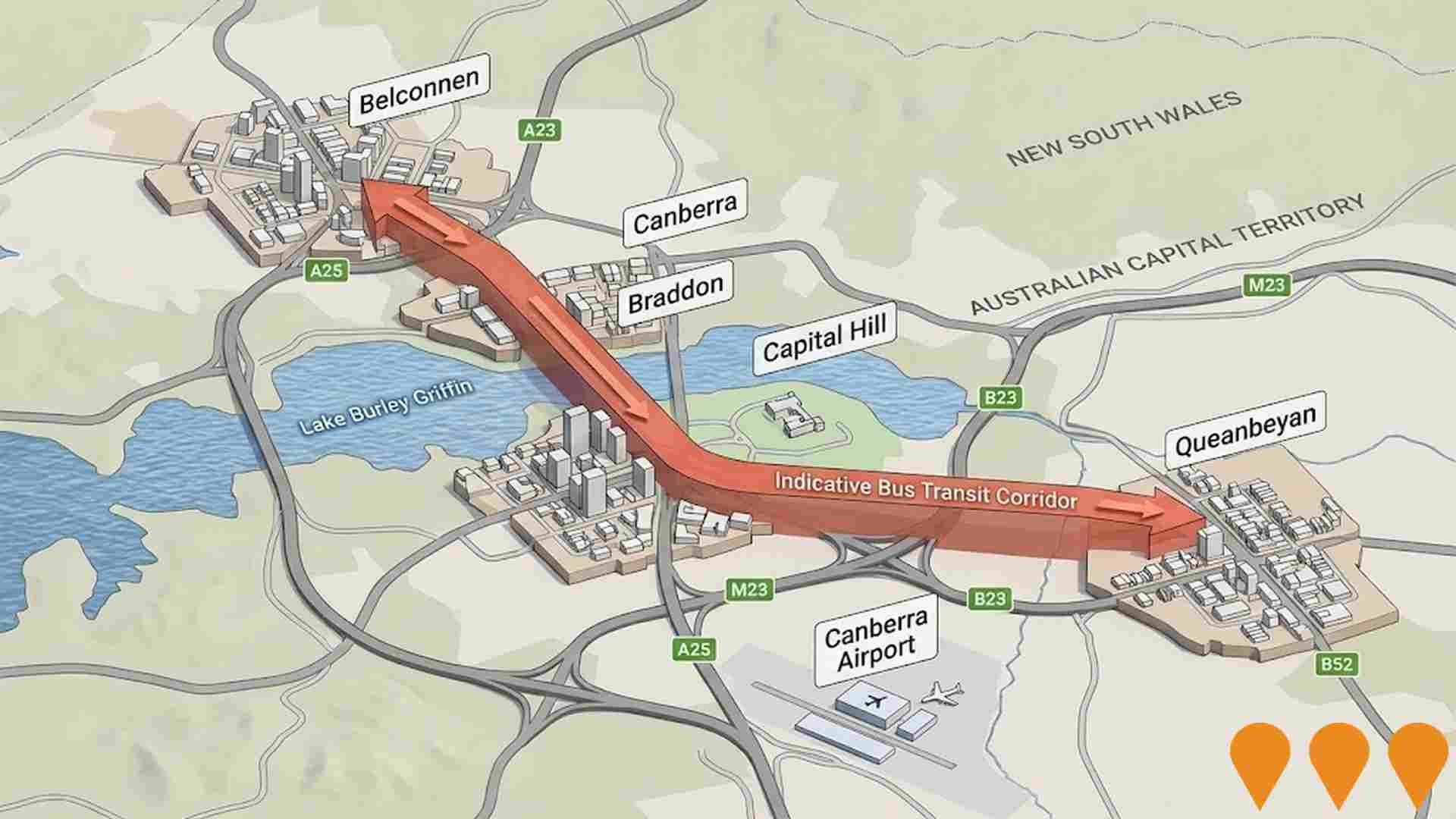
Watson Light Rail Extension
Proposed extension of Canberra's light rail network from Dickson to Watson, including a new station at Watson shops and improved connectivity to surrounding residential areas. The extension will feature sustainable design principles and integrate with existing bus networks.
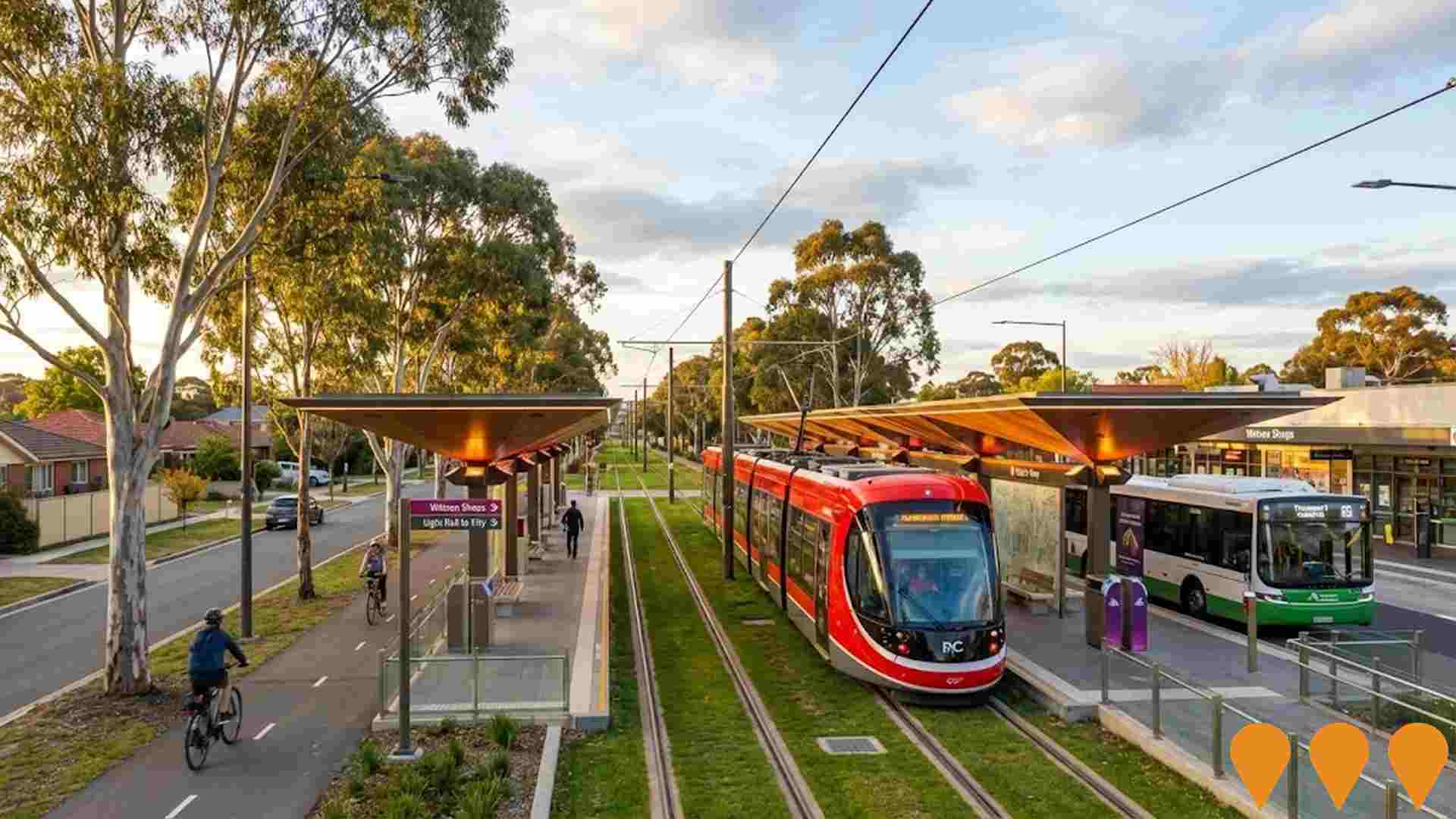
Watson Place Precinct Redevelopment
ACT Government-led master-planned renewal of the Watson local centre including new mixed-use buildings, upgraded public realm, additional retail and up to 200 new dwellings.
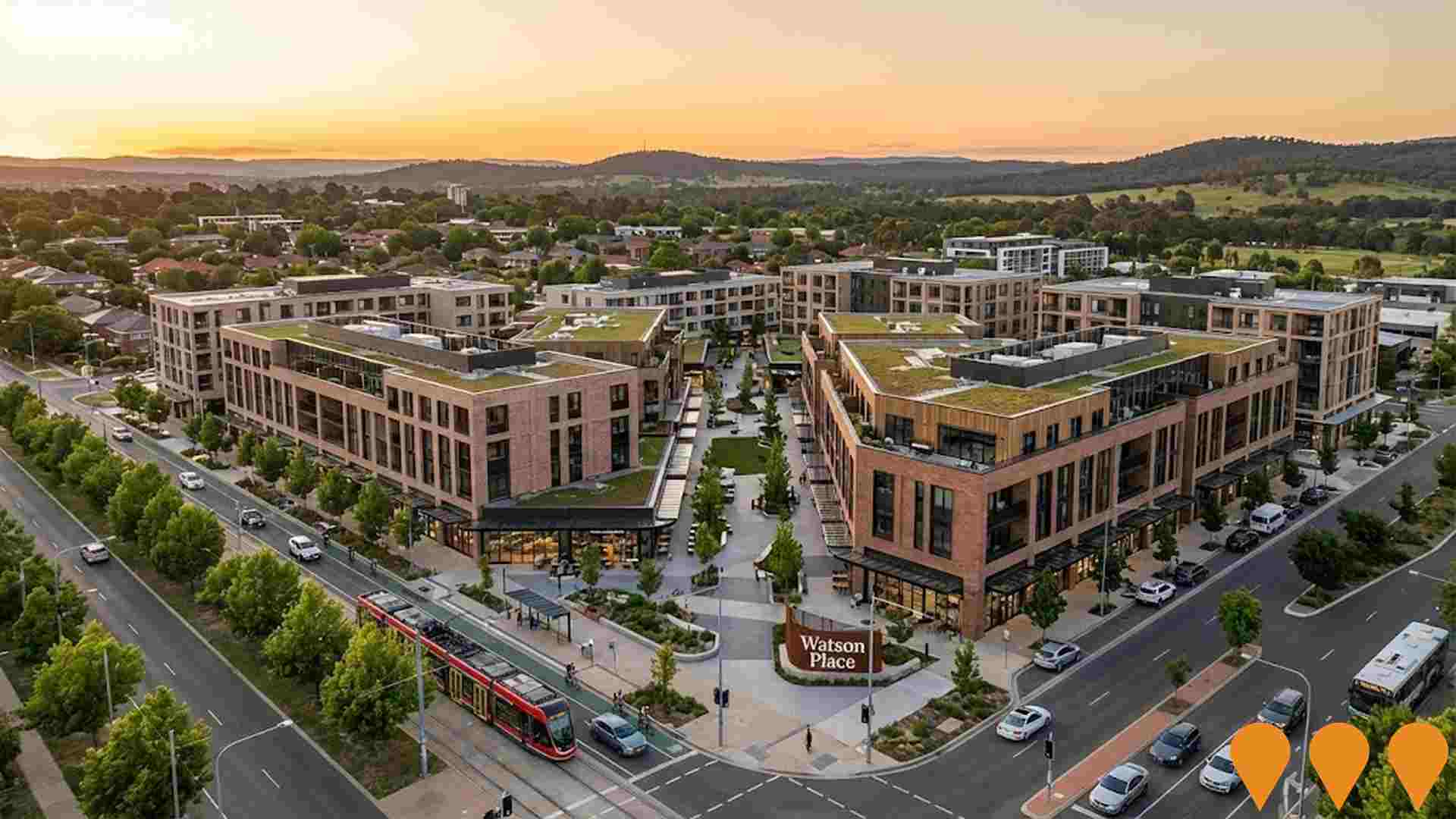
Queanbeyan Regional Integrated Transport Plan
Comprehensive transport planning initiative with 64 key actions for next 10 years. Addresses road safety, active transport connectivity, public transport availability, and future transport needs. Improved connections between Queanbeyan and ACT.
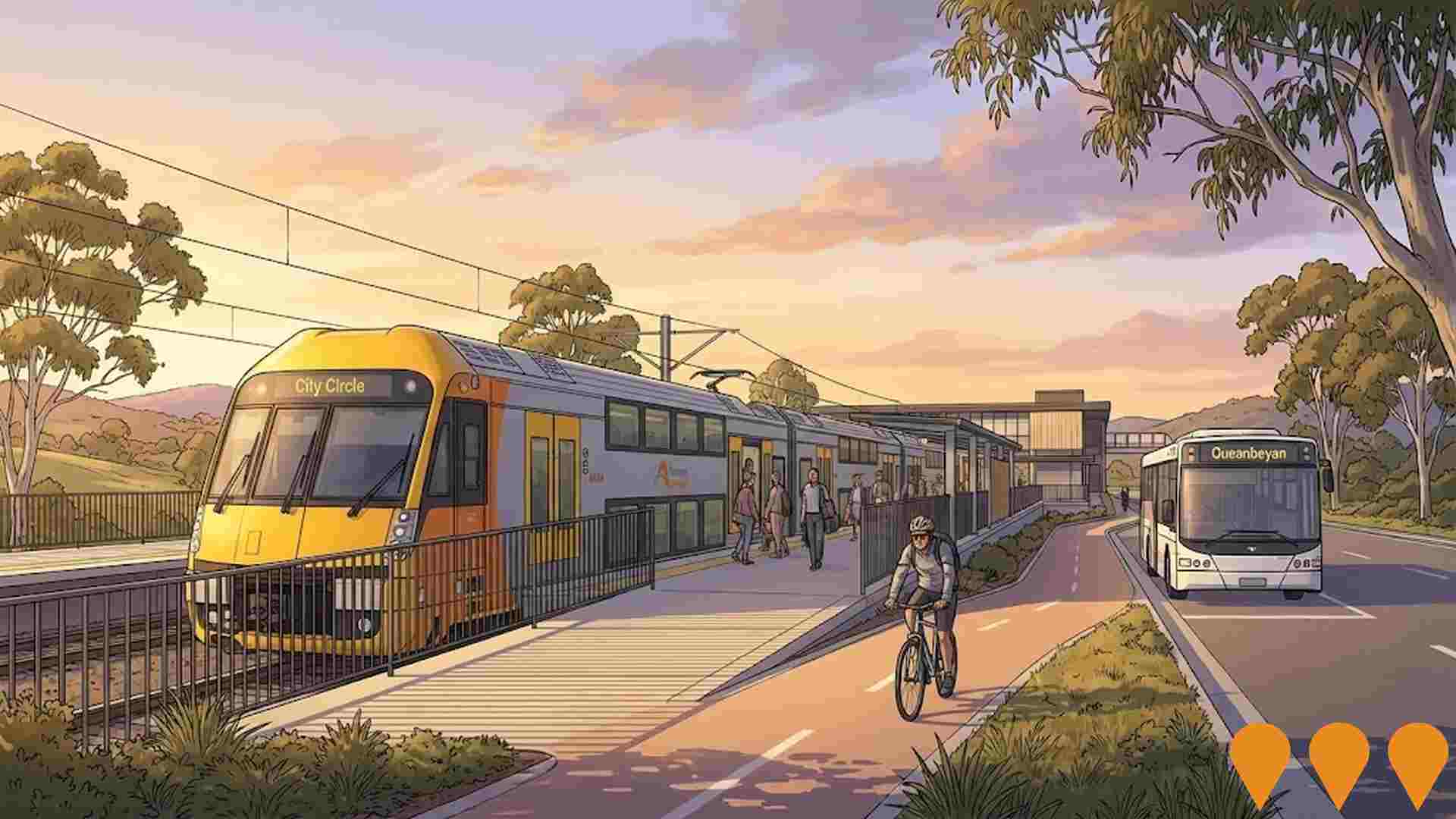
Big Canberra Battery (Williamsdale BESS)
A 250 MW / 500 MWh battery energy storage system at Williamsdale in southern Canberra, delivered by Eku Energy as Stream 1 of the ACT Government's Big Canberra Battery. Construction commenced in November 2024 with partners CPP and Tesla supplying Megapack systems. The asset will connect to Evoenergy's 132 kV network near the Williamsdale substation to provide two hours of dispatchable power, grid services and reliability for the ACT. Target operations in 2026.
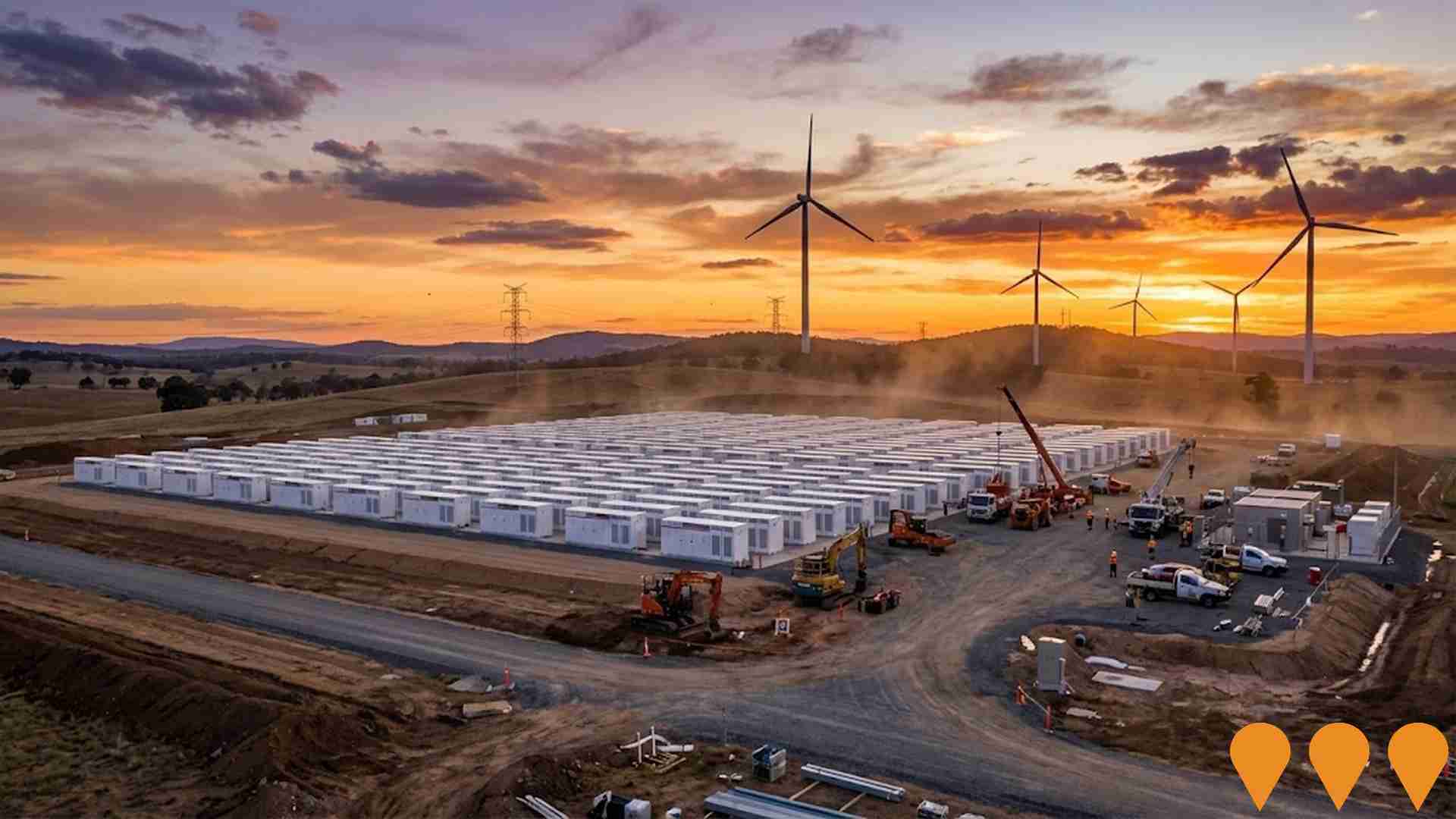
The Establishment Watson
Boutique mixed-use development by JWLand comprising 94 luxury apartments and ground-floor retail/caf‚ space directly opposite Watson Shops, due for completion in 2026.

Watson Gasworks Arts Precinct
Transformation of the former gasworks site into a creative arts precinct featuring artist studios, galleries, performance spaces, and community facilities. The heritage-listed gasometer will be preserved as a focal point. Project includes adaptive reuse of industrial buildings and new construction to create a vibrant cultural hub.
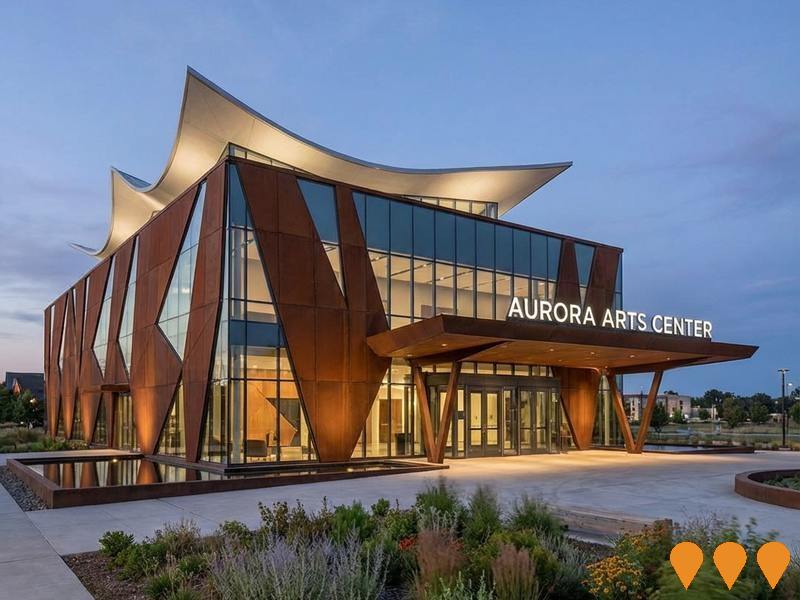
Majura Primary School Modernisation (Watson)
ACT Government project to modernise Majura Primary School in Watson. After revising enrolment projections, the program is focused on upgrading learning and play spaces rather than a large expansion. Community consultation is underway and delivery timing will be confirmed as the project develops. Learning will continue on site during works.

Employment
The employment landscape in Hackett shows performance that lags behind national averages across key labour market indicators
Hackett has a highly educated workforce with strong representation in professional services. The unemployment rate was 3.7% as of June 2025.
Employment grew by an estimated 1.5% over the past year. In Hackett, 1,772 residents were employed while the unemployment rate was 0.3% higher than the Australian Capital Territory's rate of 3.4%. Workforce participation was lower at 66.1%, compared to the Australian Capital Territory's 69.6%.
Leading employment industries among Hackett residents include public administration & safety, education & training, and professional & technical services. However, health care & social assistance was under-represented with only 8.6% of Hackett's workforce compared to 11.7% in the Australian Capital Territory. The predominantly residential area appears to offer limited local employment opportunities based on Census data. Between June 2024 and June 2025, employment increased by 1.5%, while labour force grew by 1.6%, causing unemployment to rise by 0.1 percentage points. In contrast, the Australian Capital Territory recorded employment growth of 1.9% with a fall in unemployment of 0.3 percentage points over the same period. Jobs and Skills Australia's national employment forecasts from May 2025 project national employment growth of 6.6% over five years and 13.7% over ten years. Applying these projections to Hackett's employment mix suggests local growth of approximately 6.3% over five years and 13.0% over ten years, based on a simple weighting extrapolation for illustrative purposes only.
Frequently Asked Questions - Employment
Income
The economic profile demonstrates exceptional strength, placing the area among the top 10% nationally based on comprehensive AreaSearch income analysis
Hackett's income level is among the top percentile nationally according to latest ATO data aggregated by AreaSearch for financial year 2022. Hackett's median income among taxpayers is $76,554 and average income stands at $94,635, comparing to ACT's figures of $68,678 and $83,634 respectively. Based on Wage Price Index growth of 13.6% since financial year 2022, current estimates would be approximately $86,965 (median) and $107,505 (average) as of September 2025. From the 2021 Census, household, family and personal incomes all rank highly in Hackett, between the 93rd and 96th percentiles nationally. The earnings profile shows 31.9% of population (1,055 individuals) fall within the $4000+ income range, contrasting with surrounding region where $1,500 - 2,999 bracket leads at 34.3%. Higher earners represent substantial presence with 46.8% exceeding $3,000 weekly. After housing costs, residents retain 88.2% of income, reflecting strong purchasing power and area's SEIFA income ranking places it in the 9th decile.
Frequently Asked Questions - Income
Housing
Hackett is characterized by a predominantly suburban housing profile, with above-average rates of outright home ownership
In Hackett, as per the latest Census evaluation, 76.3% of dwellings were houses with the remaining 23.6% being semi-detached homes, apartments, and other types of dwellings. This is in contrast to the Australian Capital Territory's dwelling composition which was 39.3% houses and 60.7% other dwellings. Home ownership in Hackett stood at 38.0%, with mortgaged properties at 39.0% and rented dwellings at 22.9%. The median monthly mortgage repayment in the area was $2,500, higher than the Australian Capital Territory average of $2,080. The median weekly rent figure in Hackett was $374, compared to the Australian Capital Territory's $476 and the national average of $375. Nationally, Hackett's mortgage repayments were significantly higher than the Australian average of $1,863.
Frequently Asked Questions - Housing
Household Composition
Hackett features high concentrations of group households, with a higher-than-average median household size
Family households constitute 70.5% of all households, including 37.1% couples with children, 22.8% couples without children, and 9.3% single parent families. Non-family households comprise the remaining 29.5%, with lone person households at 25.7% and group households making up 3.9%. The median household size is 2.6 people, larger than the Australian Capital Territory average of 2.2.
Frequently Asked Questions - Households
Local Schools & Education
Hackett demonstrates exceptional educational outcomes, ranking among the top 5% of areas nationally based on AreaSearch's comprehensive analysis of qualification and performance metrics
Educational attainment in Hackett is higher than national averages, with 59.7% of residents aged 15+ having university qualifications compared to 30.4% nationally and 46.8% regionally. Bachelor degrees are the most common at 29.8%, followed by postgraduate qualifications (22.4%) and graduate diplomas (7.5%). Vocational pathways account for 15.7% of qualifications, with advanced diplomas at 6.6% and certificates at 9.1%. Educational participation is high, with 34.1% of residents currently enrolled in formal education: 11.0% in primary, 10.3% in secondary, and 7.4% in tertiary education.
Blue Gum Community School serves Hackett with an enrollment of 154 students. The area's educational performance is high (ICSEA: 1158), placing local schools among the most advantaged nationally. All 1 school offers integrated K-12 education. Local school capacity is limited, with 4.7 places per 100 residents compared to the regional average of 15.4, leading many families to seek schooling in nearby areas.
Frequently Asked Questions - Education
Schools Detail
Nearby Services & Amenities
Transport
Transport servicing is moderate compared to other areas nationally based on assessment of service frequency, route connectivity and accessibility
Transport analysis indicates 14 active stops operating in Hackett. These are served by buses on seven routes, offering 215 weekly passenger trips combined. Accessibility is rated good, with residents typically 200 meters from the nearest stop.
Service frequency averages 30 trips daily across all routes, equating to about 15 weekly trips per individual stop.
Frequently Asked Questions - Transport
Transport Stops Detail
Health
Hackett's residents are healthier than average in comparison to broader Australia with a fairly standard level of common health conditions seen across both young and old age cohorts
Health data shows relatively positive outcomes for Hackett residents, with common health conditions seen across both young and old age cohorts being fairly standard. The rate of private health cover is exceptionally high at approximately 69% of the total population (2,292 people), compared to 65.3% in Australian Capital Territory and a national average of 55.3%. Mental health issues are the most common medical condition, impacting 10.0% of residents, followed by asthma at 7.6%.
A total of 67.9% of residents declared themselves completely clear of medical ailments, compared to 70.8% across Australian Capital Territory. The area has 15.8% of residents aged 65 and over (521 people), which is higher than the 11.4% in Australian Capital Territory, broadly aligning with the general population's health profile.
Frequently Asked Questions - Health
Cultural Diversity
The level of cultural diversity witnessed in Hackett was found to be above average when compared nationally for a number of language and cultural background related metrics
Hackett's population shows above-average cultural diversity, with 21.2% born overseas and 13.7% speaking a language other than English at home. Christianity is the predominant religion in Hackett, comprising 31.2%. Notably, Judaism is overrepresented at 0.9%, compared to 0.5% across Australian Capital Territory.
The top three ancestry groups are English (27.1%), Australian (23.9%), and Irish (11.6%). Other ethnicities with notable differences include Scottish (9.3% vs regional 8.1%) and Croatian (0.8% vs regional 0.7%).
Frequently Asked Questions - Diversity
Age
Hackett's population is slightly older than the national pattern
The median age in Hackett is 40 years, which exceeds the Australian Capital Territory's average of 35 years and is slightly higher than the Australian median of 38 years. Compared to the Australian Capital Territory, Hackett has a higher proportion of residents aged 45-54 (15.9%) but fewer residents aged 25-34 (10.6%). Between the 2021 Census and the present day, the proportion of residents aged 15-24 has increased from 11.1% to 13.8%, while the proportions of those aged 5-14 have decreased from 15.3% to 13.4% and those aged 35-44 have dropped from 14.7% to 13.6%. By 2041, Hackett's age composition is expected to change significantly. The number of residents aged 65-74 is projected to grow by 26%, reaching 336 from 266, with those aged 65 and above comprising 73% of the projected population growth. Conversely, declines are projected for the populations aged 45-54 and 0-4 years.




